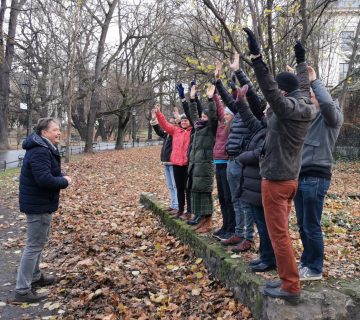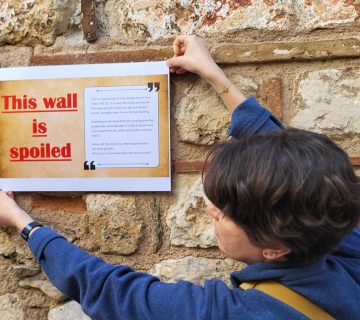Making a self-guided leaflet (Image: Sivec)
The course was delivered by IE trainer Janja Sivec and held in Slovenska Bistrica, a medium-large city not far from Maribor, in former Styria. The course was hosted by RIC (Development Information Center) Slovenska Bistrica. There we sat, behind our laptops, more or less strangers on the first day, but after five days we became colleagues exchanging ideas and points of view about words, writing and meaning-making.
I still remember the day I received an invitation from Janja Sivec. I didn′t hesitate for a second and completed the application form immediately. It had been a long time since I participated in one of the IE courses and the timing – off season – worked for me. From my experience on the Certified Interpretive Guide (CIG) course in 2017, I expected a very intensive course full of new knowledge. I was not wrong – this course took the cake!
As a group, we were a bunch of participants from all over Slovenia, with different fields of interest and professions. But from the very beginning we wanted to reach a common goal – to learn the power of words through their interpretive aspects.
It didn′t take us long to become almost like a big, happy family. I believe a clever choice of different ‘getting to know each other’ exercises and games helped us to break the ice. On the first day, we repeated some basics about heritage interpretation, the four aces and the importance of the interpretive triangle as well as starting to get familiar with usage and guidelines of interpretive writing. After some theory in the classroom, we took a stroll around the city of Slovenska Bistrica with a local guide, Jana. We were faced with the first really challenging task: We had to find a phenomenon, which would become our main occupation until the end of the course. The city itself has a rich cultural and natural heritage; the turbulent past resulted in its strategic position along a major regional crossroad. We found a lot of inspiration and material to put our interpretive writing skills to the test.
The days that followed occupied us with our phenomenon. First, we were challenged with finding a theme for our phenomenon. But with diverse exercises we managed to solve the task. Through Janja’s interactive methods, we took an active role. In a short time, we became familiar with some different possibilities of how and where to use interpretive writing. We discussed the use of efficient writing to show different perspectives and make an impact on the reader with the purpose of revealing different meanings and creating deeper connections with our heritage. We became familiar with how to write interpretive text, that attracts the reader’s attention, especially when we want to share a lot of information in a little space. We talked a lot about how to transfer strong messages and even experienced the challenge of time pressure by preparing a self-guided leaflet in under three hours. An unforgettable experience.
Nina Buh is a professor of history and sociology and works as a freelance tourist guide in Slovenia. She has been a certified tourist guide with a national license since 2015, a local guide for Destination Rogla-Pohroje since 2016 and an IE Certified Interpretive Guide (CIG) since 2017. She can be contacted at: nina.buh@hotmail.com.
To cite this article:
Buh, Nina (2020) ‘The interpretive aspect of words‘. In Interpret Europe Newsletter 1-2020, 10.
Available online:
www.interpret-europe.net/fileadmin/Documents/publications/Newsletters/ie-newsletter_2020-1_spring.pdf




